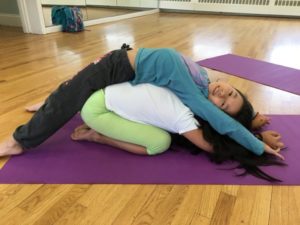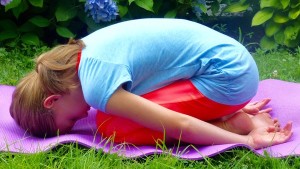Child’s Pose (Balasana) is a resting pose resembling the fetal position, usually used to return to normal calm breathing after more challenging yoga poses. In my kids’ yoga classes child’s pose becomes so much more than a quick rest! The children may turn into rocks, sloths, bugs, mice, seeds, benches, or babies, for example, as we weave imagination and creative movement throughout our yoga practice.
Child’s pose is one of the most popular asanas among my yogis, particularly those on the autism spectrum. Children with a deficient vagal system can lack the tools to self-calm, and the muscle release, relaxation and calm that this posture provides them is significant. Child’s pose is transformative for anyone who practices yoga, and I look forward to the moment my yoga instructor tells me to find my way to this heavenly, calming pose, after a long vinyasa sequence.
How To Do Child’s Pose
- From Table Pose, exhale and lower the hips to the heels, knees slightly apart, big toes touching.
- Bend forward, lay your torso between your thighs, forehead to the floor.
- Bring arms overhead with the palms on the floor, the palms or fists can be stacked under the forehead, or the arms can be along side the body.
- Stretch the tailbone away from the back of the pelvis as you lift the base of your head slightly away from the back of your neck.
- Broaden the sacrum all across the back of the pelvis.
- Breathe slowly and deeply, pressing the belly against the thighs on the inhale.
- Since this is a resting pose, you can stay in the pose for anywhere from 30 seconds to a few minutes.
- To release the asana, place the palms under the shoulders and slowly inhale up to a seated position.
Precautions and Contraindications
- Suffering from diarrhea
- Recent or chronic injury to the knee
- High Blood Pressure
Modifications and Variations
- Place a blanket under the hips, knees and/or forehead for more comfort or support.
- If pregnant, spread the knees wide apart to remove any pressure on the abdomen.
- Arms by sides to give shoulders a rest.
- Cushion between the legs for tight hips.
- Slide one arm under for a good shoulder stretch.
- Wide leg straddling bolster, lying on bolster, forehead on palms of hands.
- Open knees wide and slide arms between the legs, reaching under the body, and turn the head to the side.
Benefits of Child’s Pose
- Calms the mind. Placing your forehead (“third eye”, or just between your eyebrows) on the mat, has an instant calming and soothing effect on the brain. The body is folded inward, and eyes look backward, sending a signal to the brain that you are safe and it is okay to rest.
- Helps reduce stress and anxiety.
- Helps release tension in the chest, back and shoulders.
- Helps to massage and flex internal organs, keeping them active and supple. This pose is especially great for digestion, as by resting your belly on your thighs and taking long slow inhale and exhales, you are literally manually massaging your intestinal tract.
- Child’s pose is highly recommended if you have dizziness or fatigue.
- Helps stretch and lengthen the spine.
- Opens the hips.
- Stretches the ankles, hips and thighs.
I would like to return to my passion, an exploration of Child’s Pose as it is playfully practiced in children’s yoga. Many of my children’s yoga class themes are literacy based, all genres, for all ages. Most of these stories have critters or objects we emulate with child’s pose. The children may stretch like spiders as they walk their fingers as far forward as they can, lifting their palms off the floor. Their SPIDER then “walk” to the right, back through center, then to the left, providing a great stretch to their shoulders and lengthening their rib cage. On a walk in the park, after observing and becoming various creatures, the children may rest on a PARK BENCH, or become a LIZARD ON A ROCK, resting in the sun.

In both these partner poses, 1 child takes child’s pose (bench or rock). The partner then sits low on the child’s back, facing in the opposite direction. Carefully, the partner drapes herself over the child in the pose, so both heads are close together. The child in the backbend reaches her arms overhead and lengthens her legs straighter. Stay for a few breaths.
A fun activity that usually has the children giggling is the CHILD’S POSE WAVE. This can be done in a circle, or long line. Everyone comes into child’s pose with arms stretched long in front. The toes of the child in front will be touching the hands of the child behind her. A child starts the wave by lifting on to her knees, hands overhead and chest high. As she comes back into child’s pose, the child behind her starts to lift upward, and so on. I have done this using Lion’s Breath as a warm-up, calling out baby lion breath, or Mama, or Dad lion breath each round. This encourages deep breathing, focus and cooperation.
“If you open your heart and become like a child, you will always be content.”
Sri Dharma Mittra

Leave a Reply